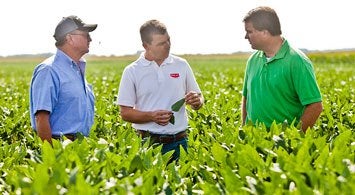
Upgrading the horsepower, size and speed of combines, planters, and sprayers can be ways of improving crop yield, but equipment is expensive and can only go so far. Tractor.com covers plant technological advances from two companies, one of which is crop broad-based and another that is alfalfa specific.
WinField NutriSolutions
Farm data collection has been going on for more than a decade, but putting that data to use has lagged behind. With windfall commodity prices, perhaps there wasn’t a driving need. But today, with prices challenging bottom-line profits, attention to data can no longer be ignored. Enter WinField NutriSystems, a Land O’Lakes company, who markets top-performing seed and crop protection products such as CROPLAN, Answer Plot, R7 Tool, MAX-IN and NutriSolutions 360.

Over the past six years, NutriSolutions has sampled more than 300,000 tissue samples taken from a wide variety of crops across much of the U.S. That data has shown nutrient deficiencies in a high percentage of samplings, with 75% of corn samples deficient in zinc, 60% of soybean samples deficient in copper, 85% of alfalfa samples deficient in calcium, and 75% of wheat samples deficient in boron.
Excessive rainfall in 2014 and the resultant sustained wet soil conditions also flagged nitrogen and sulfur deficiencies. Growers participating in NutriSolutions in-season tissue sampling were able to adjust nutrient applications throughout the year, yielding positive results. Those results include more growers achieving targeted yields along with fewer standability or stalk quality issues.

According to Todd Cardwell, WinField regional agronomist, best results were seen with tissue sampling at key growth stages throughout the season. In corn, sampling is recommended at V4 to V5, V10 to V11 and VT to R1. For soybean, sampling is recommended at V4, R1, and R2 to R3. Farmers participating in the program send samples to a NutriSolutions certified lab with results completed in a few days. If the samples prove nutrient levels are optimum or deficient, farmers can act quickly to protect yield potential. Corn growers participating in the NutriSolutions program have seen deficiencies identified as early as V5.
Using today’s tissue data to plan for next year’s plant nutrient needs has proven a powerful, positive tool to affect yields. Using tissue sampling at key growth stages throughout the season and then adjusted in-season is the next logical step.

Forage Genetics International HarvXtra
For producers of alfalfa, there has always been a trade-off of yield vs. quality. Lignin, which is akin to rebar in concrete, provides the plant with structural integrity but is indigestible and binds with cellulose – reducing fiber digestibility. As alfalfa advances in maturity, the lignin content increases. For traditional alfalfa seed, harvest takes place at late bud to 1/10 bloom. At this point, the hay is of high quality. Delay the harvest and yields go up, but the quality of hay suffers. This is where reduced-lignin (R-E) trait or genetically engineered (GE) seed comes into play.

Forage Genetics International (FGI), the 1991 result of a union of industry-leading forage companies, maintains more than 40 research, testing and production facilities in the U.S. alone. In partnership with The Samuel Roberts Noble Foundation, the U.S. Dairy Forage Research Center (USDFRC), and Monsanto, FGI has developed the industry’s first quality-enhancing reduced-lignin seed. Going by the trade name HarvXtra, FGI’s R-E seed can improve yields as much as 15 to 20% by reducing the number of harvests required. That could mean a certain geographic location requiring four harvests per year, switching from conventional seed to a R-E product, production of the same or better quality hay could see a reduction to just three.
The advantages don’t stop with reduced harvesting time. R-E alfalfa allows animals to increase their rate of digestion which increases dry matter intake and milk produced. The environmental upshot is that a reduction in manure as measured against gallons of milk produced results. USDFRC estimates that a 10% increase in fiber digestibility would increase milk/beef production by $350M/year while decreasing manure products by 2.8M tons/year. And with higher yields, longer cutting schedules, reduced fossil fuel usage through decreased harvesting, water use efficiency will also improve.
With the United States Department of Agriculture (USDA) poised to deregulate R-E trait seed (HarvXtra alfalfa is not currently available for sale; however a petition to deregulate is currently under review by the USDA with the comment period closing June 30, 2014 and a limited commercial introduction expected in 2016), interested growers should stay attuned to the latest news. When R-E alfalfa does become available, those employing this technology can expect greater crop flexibility, a wider cutting window, greater milk output, and better profitability. Those truly are traits worthy of adding to the farm toolbox. Then perhaps the old adage, “you’ll never see alfalfa blossoms from seeding through plow down”, will go the way of other disproven farm myths.

 Your Privacy Choices
Your Privacy Choices